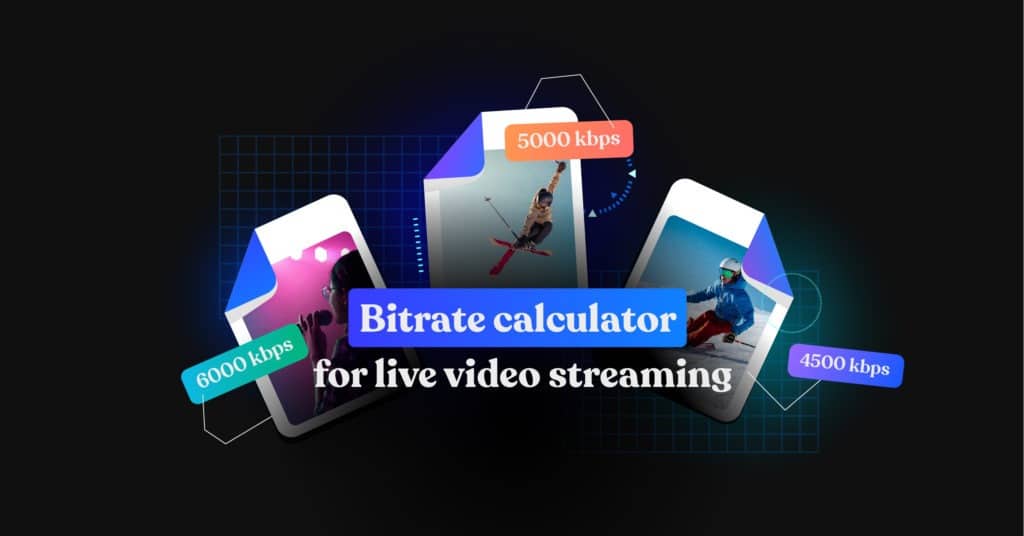Live Streaming Bitrate Calculator
Find the best bitrate for your live stream
PROFESSIONAL LIVE STREAMING TOOL FOR EVERYONE
SIGN UP FOR A 7-DAY TRIALRecommended Bitrate
- kbps
Max Bitrate
kbps
How to use Live Streaming Bitrate Calculator?

Live Streaming Bitrate Calculator is a tool that helps you calculate the recommended and maximum bitrate for your Live Stream in order to make sure that your viewers can watch your stream without buffering or lag. Using our bitrate calculator you can get the accurate video bitrate and audio bitrate required for live streaming and video hosting.
Your total bitrate depends very much on your internet connection. Having high bitrate setting requires very stable internet connection. If your internet connection can’t keep up, you will notice lags and buffering during the stream. if you are streaming using h265 format then you will be able to get a higher quality video with a very low bitrate because of the video compression. H264 is widely used for video delivery and for getting the best quality video the bitrate needs to be higher.
The perfect balance of video quality and internet connection speed is a difficult thing to find. Use this calculator to find that sweet spot.
Make sure you stay within the recommended bitrate and do not exceed your maximum number as the calculator suggests.
What is bitrate?
Bitrate is the rate at which you send bits to the streaming platform. It measures how much data of your audio and video information is transmitted in a given amount of time. Audio bitrate and video bitrate are commonly measured in kilobits per second (kbps) and megabits per second (Mbps). The higher the bitrate, the faster your internet connection when streaming video content online with video streaming software.
Internet Upload Speed
Internet upload speed is the rate at which a device can send data over an Internet connection. It’s usually expressed in megabits per second (Mbps). Upload speeds are always slower than download speeds because it takes more work for your ISP to transmit video and audio stream data from you to another computer or server on the internet instead of downloading content that’s already uploaded and stored somewhere else.
You can check how fast your upload speed is by going to speedtest.net
If your upload speed is greater than the bitrate for given video quality and video file size, you should be able to use that quality without having any issues.
What percentage of Upload Speed to use?
The percentage of your upload speed used for streaming is different depending on how many programs you have open that are also using the internet connection. For example, if there’s an internet browser open then it usually takes up some amount as well, which means less amount allocated for your stream.
Frames per second (FPS)
Frames per second (FPS), also known as frame rate, is the frequency of consecutive images called frames appearing on display. The higher number of FPS means smoother motion and less lag time between each image change. The most common frame rates are 30 fps for standard video, and 60 fps for high-definition displays
Video Resolution
Video Resolution is the number of pixels in a video picture or its display resolution. The higher the resolution, the more detailed your picture will be.
The most common resolutions for streaming are:
- SD Video (1280 x 720)
- HD Video (1920 x 1080)
SD video resolution refers to the standard definition. This is the most common type of video resolution you’ll find on your computer screen because it’s been around so long.
On the other hand, HD video resolution refers to high definition. This is the newer line of video resolutions that have become popular in recent times, and it offers a much more detailed picture than SD because it uses more pixels.
HD streaming needs a higher bitrate and, as a result, needs high upload speed. If your internet connection isn’t very good- choose SD instead of HD.
Bitrate Recommendation for each platform
Below are the recommended bit rate for Youtube, Twitch, and Facebook. Make sure to change the bit rate from streaming settings before streaming.
Youtube Bitrate Recommendation
Refer to this link for full guidelines
Video Resolution (Pixel)
Video Frame (Frames per second)
Recommended Video Bitrate (kilobytes per second)
Recommended Upload Speed (Megabits Per Second)
720p
30fps
1500-4000 kbps
2-5 Mbps
720p
60 fps
2250-6000 kbps
2.9-7.4 Mbps
1080P
30 fps
3000-6000 kbps
3.8-7.4 Mbps
1080P
60 fps
4500-9000 kbps
5.6-11 Mbps
1440P
30 fps
6000-13,000 kbps
7.4-15.8 Mbps
1440P
60 fps
9000-18,000 kbps
11-21.8 Mbps
4K
30 fps
13,000-34,000 kbps
15.8-41 Mbps
4K
60 fps
20,000-51,000 kbps
24.2-61.5 Mbps
Twitch Bitrate Recommendation
Video Resolution (Pixel)
Video Frame (Frames per second)
Recommended Video Bitrate (kilobytes per second)
Recommended Upload Speed (Megabits Per Second)
720P
30 fps
2500-4000 kbps
3.2-5 Mbps
720P
60 fps
3500-5000 kbps
4.4-6.2 Mbps
1080P
30 fps
3500-5000 kbps
4.4-6.2 Mbps
1080P
60 fps
4500-6000 kbps
5.6-7.4 Mbps
Facebook Bitrate Recommendation
Refer to this link for full guidelines
Video file options:
Audio file options:
Video options:
- Resolution: 1080p (1920 x 1080)
- Frames per second: 30 fps
- Video bitrate range: 3,000-6,000 Kbps
- Keyframe: 2 seconds
- Video codec: H.264, Level 4.1
- 8-hour time limit
Audio options:
- Sample rate: 44.1 kHz
- Channel layout: Stereo
- Audio bitrate: 128 Kbps
Join 200,000+ satisfied streamers
Still on the fence? Take a sneak peek and see what you can do with Castr.
- Free 7-day trial
- Cancel anytime
- No credit card required